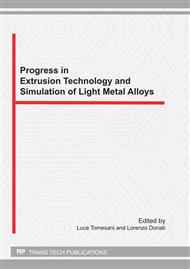[1]
K. Laue, H. Stenger, Extrusion – Process, Machinery, Tooling, ASM, Metals Park, (1981).
Google Scholar
[2]
P. Saha, Aluminum Extrusion Technology, ASM International, Ohio, (2000).
Google Scholar
[3]
J. Wantuchowski, J. Zasadziński, J. Richert: Badania nad zastosowaniem matryc mostkowych w praktyce wyciskania na gorąco aluminium i jego stopów, AGH University of Science and Technology Publications, Metallurgy and Foundry, 438, 59 (1974).
Google Scholar
[4]
R. Akeret, Extrusion welds – quality aspects are now center stage, Proc. 5th Aluminium Extrusion Technology Seminar ET'92, Chicago, 319-336, (1992).
Google Scholar
[5]
J. Zasadziński, J. Richert, W. Z. Misiołek, Weld quality in extruded aluminum hollow sections, Light Metal Age, t. 51, nr 4, 8-13, (1993).
Google Scholar
[6]
H. Valberg, Extrusion Welding in Porthole Die Extrusion, Proc. 6th Int. Aluminum Extrusion Technology Seminar ET'96, vol. II, Chicago 1996, pp.213-224.
Google Scholar
[7]
L. Donati, L. Tomesani, Seam welds in hollow profile extrusion: process mechanics and product properties, Materials Science Forum, vols. 604-605, 121 – 131, (2009).
DOI: 10.4028/www.scientific.net/msf.604-605.121
Google Scholar
[8]
I. Duplancic, J. Prgin, Determination of parameters required for joining process in hollow dies, Proc. 6th Int. Aluminum Extrusion Technology Seminar ET'96, Chicago, 225-230, (1996).
Google Scholar
[9]
M. Plata, J. Piwnik, Theoretical and experimental analysis of seam weld formation in hot extrusion of aluminum alloys, Proc. 7th International Aluminium Extrusion Technology Seminar ET'2000, Chicago, 205-211, (2000).
Google Scholar
[10]
J. Zasadziński, J. Richert, W. Libura, M. Galanty, D. Leśniak, A. Rękas, Dobór warunków zgrzewania trudno odkształcalnych stopów aluminium przeznaczonych do wyciskania kształtowników na matrycach mostkowo-komorowych, Rudy i Metale, R. 54 2009 nr 3, 148-152, 2009 (in Polish).
DOI: 10.15199/67.2019.4.3
Google Scholar
[11]
J. Zasadziński, A. Rękas, W. Libura, J. Richert, D. Leśniak, Numerical Analysis of Aluminium Alloys Extrusion Through Porthole Dies, Key Engineering Materials, vol. 424 (2010), pp.105-111.
DOI: 10.4028/www.scientific.net/kem.424.105
Google Scholar
[12]
L. Donati, L. Tomesani, Evaluation of mew FEM criterion for seam welds quality prediction in aluminum-extruded profiles, Proc. 8th Int. Aluminum Extrusion Technology Seminar, vol. 2, 2004, pp.221-234.
DOI: 10.1016/j.jmatprotec.2004.04.215
Google Scholar
[13]
R. Akeret, Properties of pressure welds in extruded aluminum alloy sections, Journal of the Institute of Metals, vol. 100, 202-207, (1972).
Google Scholar
[14]
J. Zasadziński, W. Libura, J. Richert, Prędkość wypływu trudnoodkształcalnych stopów Al podczas wyciskania w temperaturach bliskich temperatury topnienia, Rudy Metale, vol. 50, 2005, nr 12, s. 686-689 (in Polish).
Google Scholar
[15]
J. Richert, J. Zasadziński, W. Libura, M. Galanty, D. Leśniak, A. Rękas, Sposób i urządzenie do badania zgrzewalności metali i stopów, zwłaszcza stopów aluminium przeznaczonych do wyciskania na matrycach mostkowych, Patent nr P-390 383, AGH Kraków, 2009 (in Polish).
Google Scholar
[16]
D. Leśniak, M. Bronicki, A. Woźnicki, High-temperature homogenization of AlCuMg alloys for extrusion in T5 temper, Archives of Metallurgy and Materials, vol. 55, issue 2/10, 499-513, (2010).
DOI: 10.2478/v10172-011-0148-z
Google Scholar


